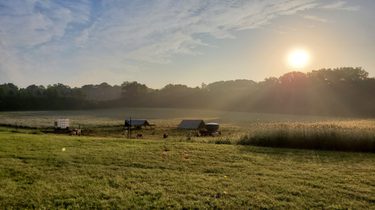
Saving Seats at Proverbial Table: A Call to Bring More Farmers, Ranchers into Climate Conversations

It is S2G’s belief that agriculture is at the front lines of the fight against climate change and is increasingly becoming a focal point in conversations on mitigation and adaptation, highlighting the sector’s integral role in shaping a sustainable future. However, S2G has observed that there’s a palpable underrepresentation at many of the discussion tables and in many climate and ag-focused conferences and convenings: the farmers themselves. While farmers are often a point of reference in the discussions, they are not always present to contribute. This leaves a gap in the dialogue, as those who work the land and feed the world often lack the opportunity to contribute to the solutions and share their invaluable firsthand experiences and insights.
According to the 2022 IPCC report, agriculture, forestry, and other land uses comprise 22 percent of global greenhouse gas emissions, and food systems as a whole are responsible for a third of anthropogenic GHG emissions. As a result, agriculture has become increasingly central to the climate conversation. Last year was the first time that the Conference of the Parties (COP), an annual gathering where representatives from countries around the world come together to discuss and coordinate efforts to tackle climate change, addressed food and agriculture with a dedicated Agriculture and Food Pavillion on-premises. However, some organizations sounded the alarm about the forum’s lack of inclusivity and the absence of farmers’ voices at the conference.
The first United Nations Food System Summit, held in September of 2021, was hailed by many as a pivotal step forward for food and climate. But hundreds of food sovereignty organizations, smallholder and indigenous farmers groups, and scientists boycotted the summit because they felt it over-represented big agribusiness. In May, the AIM for Climate, a joint U.S.-U.A.E. initiative developed in partnership with some of the world’s biggest food, chemical, and seed companies, took place. Farmers were noticeably sparse.
Meanwhile, the implementation of certain climate-focused agricultural policies has been met with substantial backlash from farmers. For months, Dutch farmers have been protesting government plans to cut nitrogen emissions in half by 2030 by reducing the country’s livestock by a third. Convoys of tractors brought traffic in Brussels to a halt in March as thousands of Belgian farmers protested the Flemish government’s plans to limit agricultural nitrogen emissions. Dublin and Berlin have seen similar protests.
We believe that if we truly want to see a transformation in the agricultural sector to better support climate objectives, we believe farmers must be a fundamental voice in these conversations. The farmers’ lived experience must be paired with science, new practices, and technologies to make progress. It is our view that we need to focus on how these practices drive profitability — not costs — and that farmers need to be fully incorporated into the decision-making and implementation processes for change to happen at the speed and scale necessary to meet today’s climate and agricultural challenges.
That being said, we understand that it is far from easy. We know from our annual S2G Summit how difficult it can be to bring farmers into these spaces. The Summit is held in May, which is a critical planting time for many farmers. We want to find ways to address this issue within our own ecosystem and so we set out to interview farmers and individuals from farming organizations to learn about some obstacles preventing farmers from participating in climate conversations and opportunities to improve inclusivity for the agricultural community.
Where, When, and What Does It Cost?
Sometimes, it just comes down to logistics. Depending on management capacity, it can be difficult for farmers to leave their operation for even a day. If an event occurs during a critical part of the year, it may make participation almost impossible. For example, COP takes place in November, a critical harvesting time in much of the world.
According to Ryan Slabaugh, founder and director of Think Regeneration, a nonprofit building on-the-ground programs nationwide to support regenerative farmers and ranchers, one opportunity to make conferences more accessible is to move the event from the city to the farm. He spoke about recently attending the Regenerate AZ conference, where participants across the food supply chain camped on a farm. Slabaugh recounted that one morning, they realized that the sheep had gotten out of the rotational grazing pastures. Most of the participants immediately jumped in their trucks to address the situation. This is a small but significant example of connecting the conference’s content to the lived experience of farming. We recognize that it would not make sense to bring most conferences to the farm. But it may be feasible for some smaller conferences, and larger conferences to consider experimenting with a satellite farm-based component.

Shari Rogge-Fidler is the president and CEO of Farm Foundation, an organization that leverages the power of collaboration between food and agriculture stakeholders to advance agriculture in positive ways. Farm Foundation established an Ag 101 Bootcamp to bring stakeholders across the food system to its farm campus to help them understand in a visceral way what it will take to advance regenerative ag. According to Rogge-Fidler, “We find that investors and decision makers are making these big, bold bets on regenerative agriculture, but they don’t fully understand what it takes to get and keep those millions of acres in regenerative agriculture.” She felt participants left the boot camp with an understanding of the realities of regenerative agriculture “in a way that wouldn’t come across in a conference room.”
Additionally, Slaubaugh asserts that the setting is an important factor in how farmers navigate these conversations. “Farmers have more confident voices in environments they are comfortable in,” he says. Slabaugh also mentioned the conference prices. A farmer-discounted ticket that costs $800 is not feasible for most farmers. Even if conferences are free, it is still a hard sell with travel and time away from the farm. We believe that if these forums want to include a broader spectrum of farmers, financial support for the ticket, travel, and accommodations will go a long way.
Keep It Genuine
Rogge-Fidler is joining a coalition of farmers at COP this year. Farm Foundation is a think-and-do tank and is committed to not just discussing ideas but implementing meaningful solutions to some of the most important challenges facing farmers. However, according to Rogge-Fidler, there are people who attend these conferences just to say they were there. She notes this is something that doesn’t sit well with many farmers who need to be clear on why they should be there. “Most farmers are pretty practical, and they don’t just want to support greenwashing or help an investor make their returns,” she says.
Ryan Erisman raises grass-fed beef, acorn-finished pastured pork, and feed crops for the hogs on a small-scale regenerative farm in Wisconsin. He served as a United States Marine Corps officer for over a decade with two deployments to Iraq and currently runs a leadership coaching and consulting business in addition to farming. According to Erisman, being genuine is the crucial starting point for having these conversations. “Stakeholders have to be willing to listen, and to let go of their own agenda first,” he says. “There has to be a genuine effort from the convener to drop everything they think they know and walk into a situation open and curious. That’s extremely hard for all of us. But it’s the best way to move forward together.”

Language and Positioning Are Critical Components
According to Rogge-Fidler, “much of the public dialogue around agriculture and climate feels like a finger is being pointed at farmers and that they are under threat. So why would they want to come into the room? Many farmers believe they are a core part of the solutions and, in some cases, are leading the innovations and change.”
We believe language and terminology can also be determinants of inclusivity. Today, more and more farmers recognize the need to adapt to climate change, but it is our view that the conversation should center around the language and topics that farmers care about and are comfortable with. “Soil health is the common denominator with all farmers,” says Rogge Fidler. “We can talk about how important soil health is for all kinds of different outcomes.” Rogge-Fidler says that on many family farms, stakeholders hold a wide range of perspectives, so the farm stakeholders might focus on soil health practices and the benefits of specific interventions for the soil as opposed to framing them in terms of sustainability or climate.
As another example of this, Slabaugh has observed that “farmers will get on stage and talk about their difficulties with understanding and participating in carbon markets, and this will be followed by two hours of talking about developing carbon markets.” In a study published in Nature, researchers used semi-structured interviews to assess both conventional and organic farmer perspectives on soil carbon offset programs. Farmers in both groups expressed concerns about the convoluted, burdensome, and unpredictable nature of participating in these markets, and emphasized that they were implementing practices for their own business interests and concerns for the well-being of their land and operation, not the financial incentive of carbon credits.
Understanding the Farmers’ Why
A recent study on influences that lead to the decisions and acts of implementing sustainable practices found that climate considerations are not an essential driver among farmers who have implemented relevant measures. Rather, these measures are mainly perceived as offering farm-beneficial functions other than climate change mitigation, such as improving soil health, water retention, and crop resilience or minimizing input costs.
Ty Fickenscher operates two farms in Nebraska, one of which he is transitioning to organic with the support of our portfolio company, Clear Frontier. He says he wouldn’t necessarily go to a conference on how to reduce emissions on farms because he is already doing what he can to reduce emissions. “My number one goal is to be profitable,” he says, “and I have to know how any technology or practice will impact profitability.”

Connecting climate objectives to farm profitability can be critical to getting farmers on board. Farm Foundation’s Ag 101 Bootcamp includes a module on farm-level economics so participants can understand what the financials of implementing these practices look like for farmers and what it would take to fit these changes into the farm balance sheet.
But maybe most importantly, we believe actors across the food system must thoroughly consider farmer motivations. According to Rogge-Fidler, we have to make sure we understand and incorporate the farmer’s why. “A farmer doesn’t exist to help you hit your sustainability targets as a corporation,” she says. “That might be your why, but that’s not the farmers’ why. We have to look at our shared goals.”
According to Erisman, “We need to understand farmers’ whys –the individual and cultural values that underpin their decisions.”
Our belief is that conferences can better position themselves to address more of the farmer’s why by focusing on how practices impact farm profitability and how they will help them save their farming operations for generations to come. There should be clear messaging and intentionality about how the conference’s objectives will help further farmers’ goals and not just improve sustainability metrics.
Heading in the Right Direction
The agenda for COP28 includes a full day dedicated to food, agriculture, and water and another focused on nature, land use, and oceans. The UAE is preparing an “Emirates Declaration on Resilient Food Systems, Sustainable Agriculture and Climate Action,’’ which at least fifty (and possibly closer to 100) countries are expected to sign, according to David Nabarro, senior advisor to the COP28 food systems team. At this point, 100 countries have included actions on agriculture production in updated Nationally Determined Contributions or NDCs, which represent each country’s commitment to reducing GHG emissions and adapting to climate change.
We believe these are all promising developments. But we believe the only way to ensure that the intentions set at climate conferences are implemented and have the desired impact is to bring as many farmers with diverse backgrounds and perspectives into the conversation as possible. Farmer and rancher voices are essential, not only to ensure that the strategies developed are grounded in practicality but also to capture their innovations and acknowledge and empower those who are most affected by and can combat climate change. It will by no means be easy, but we believe it is a worthwhile effort. These conversations were an incredible learning opportunity for us, and we hope to continue these conversations and find ways to uplift farmer viewpoints and experiences as we work towards food systems that support planetary health and the farm bottom line.


